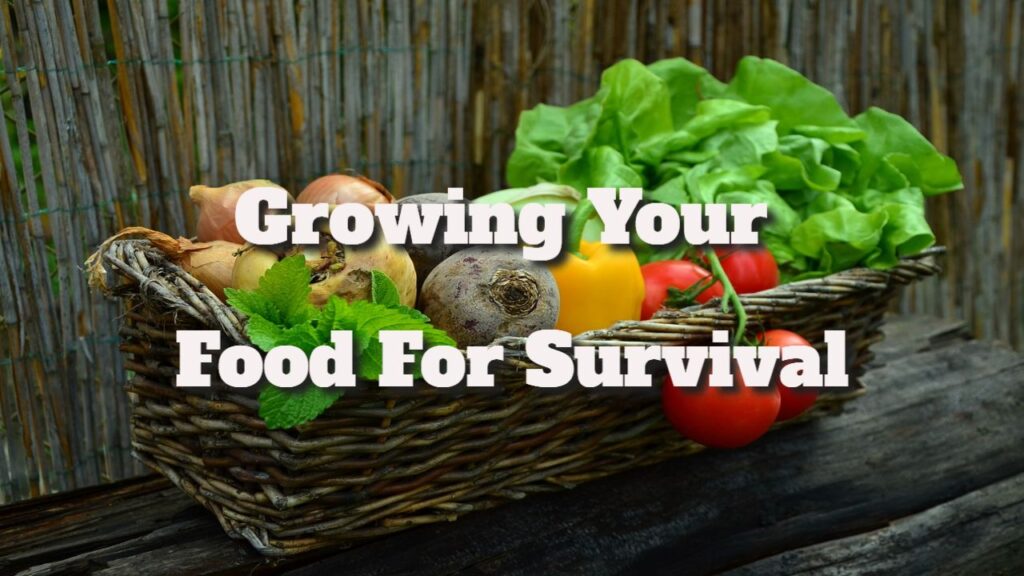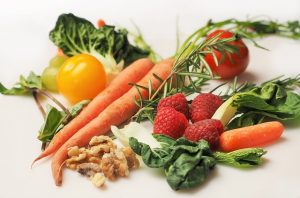Growing your Food for Survival – Tips and Practices
Growing one’s survival food is becoming increasingly popular today. With the rise of natural disasters, global pandemics, and economic uncertainty, more people are turning to self-reliance for survival.
Growing your own food means having access to fresh, nutritious produce even when in distress.
One of the significant benefits of growing your food is having complete control over what you consume.
You may grow organic produce devoid of harmful pesticides and chemicals, ensuring you and your family have healthy and nutritious meals.
Furthermore, growing your food can save you money in the long run by reducing the need to buy expensive grocery store items.
Whether you have a large garden or a little balcony, there are several ways to grow your fruit. Traditional vegetable patches, container gardens, and hydroponics are a few options for any location or budget.
You may prepare yourself and your family for various situations by learning how to grow food.

Understanding the Basics of Food Growing
Choosing the Right Plants
If you want to grow your food, choosing the right plants is crucial. You should choose plants suited to your climate and soil conditions, as well as those that are easy to cultivate and care for.
Tomatoes, lettuce, beans, and peas are some of the most popular crops for beginners. You may get a lot of produce from these crops with little effort.
Soil Preparation and Care
Your plants’ success is directly proportional to the quality of your soil. Before sowing, prepare the soil by removing weeds and debris and adding organic materials such as compost or fertiliser.
This enhances soil structure and fertility while delivering essential plant growth elements. To ensure optimal soil health for plant growth, amend the soil regularly with compost or other organic materials and monitor the pH level during the growing season.
Strategies for watering
Proper watering is essential for healthy plant growth. Overwatering can result in waterlogging and root rot, whilst underwatering causes plants to droop and die. Maintaining a balance and watering the plants regularly but not excessively is vital.
Watering thoroughly once or twice a week is an excellent general rule of thumb, but it can vary depending on the weather and soil conditions. Mulch can also act as a soil moisture retainer, reducing the amount of watering required.
If you grasp the fundamentals of food cultivation, you can start a garden and offer fresh, nutritious food for yourself and your family. With the right plants, proper soil preparation and care, and appropriate watering techniques, you may reap a bountiful harvest while having fun cultivating your food.
Set up your garden.
Garden Design and Layout.
Consider your space and how much light your plants will receive as you design your garden. Select a place that receives at least six hours of sunlight per day. Consider your location’s soil type and water drainage.
Plan your garden based on the space available and the plants you want to grow. Consider the size of the plants when they are growing to ensure they have enough space. A landscape planner can help you with this operation.
Complementary planting
Complementary gardening involves mixing plants that benefit each other. For example, putting marigolds near tomatoes can help prevent pests drawn to them.
When building your garden, think about growing companion plants. Determine which plants function well together and which should be separated. This can improve plant health while reducing the need for insecticides.
Pest Control
Pest management is an essential aspect of gardening. Pest management can be achieved using various methods, including natural predators such as ladybirds and organic insecticides.
Learn about the pests in your area and select an effective pest control solution. Never use more insecticide than is suggested; doing so may harm your plants and the environment.
By adhering to these recommendations, you can successfully construct your garden and cultivate food for survival.
Harvesting and storing food
Harvesting Techniques
When harvesting your produce, you can take a few steps to help your plants thrive. Remove the earth around the plant using a garden fork before plucking up root crops such as carrots and potatoes.
Use a sharp knife or scissors to cut the leaves at the base of leafy plants, such as lettuce and spinach. Gently twist or cut ripe fruits from the plant, such as tomatoes and strawberries.
Preservation methods
Food must be adequately stored after harvesting to ensure its long-term viability.
Canning is one of the most accessible ways to preserve food. This involves boiling the food in a jar to kill all bacteria before sealing it to keep new bacteria out.
Another standard method of preservation is drying. This comprises removing as much moisture as possible from the food by hanging it to dry naturally or using a dehydrator.
Finally, freezing is a great way to keep food for an extended period. Preparing food for freezing is as simple as washing and cutting it before storing it in a container or bag.
Seed Preservation and Storage
If you want to grow your food in the future, you must conserve and store your seeds properly. The first step is to thoroughly dry the seeds before storing them.
Spread them out flat and let them air dry for a few days. When the seeds have dried, please place them in a sealed container and store them in a cold, dry area.
Write the seed variety and harvest date on the container label. This allows you to trace your seeds and ensure they are viable for future sowings.
The post Growing your Food for Survival – Tips and Practices appeared first on Survival Avenue.
The Article Growing Your Food for Survival – Tips and Practices was found on https://limitsofstrategy.com
The Article Growing Your Food for Survival – Tips and Practices First Appeared ON
: https://ad4sc.com



This is a vital topic in today’s context, especially as we continue to navigate the unease brought about by global events. The idea of self-sufficiency through growing one’s food resonates with many, not just as a survival tactic but also as a lifestyle choice aimed at sustainability and health.
You’ve touched on a really important point about how our current context has made many people reassess how they approach food and sustainability. The idea of self-sufficiency isn’t just a response to external pressures; it’s also a way to reclaim control over what we eat and how we live. Many folks are discovering that growing their own food provides a deeper connection not only to their meals but also to the environment.
You’ve really captured the essence of what many are experiencing right now. The idea of self-sufficiency does seem to resonate on many levels—it’s about more than just growing food; it’s an act of empowerment and a tangible response to our complex relationship with the food system.
You really hit the nail on the head with that observation! Self-sufficiency goes so much deeper than just having a vegetable garden or raising chickens; it’s about reconnecting with our roots, both literally and figuratively. For many, this journey is less about perfecting the art of farming and more about reclaiming a sense of control over what we consume and how we live.
I completely agree, and it’s interesting how the movement toward self-sufficiency can be seen as a response to the modern world’s pace and complexities. The act of growing our own food or tending to animals becomes a pathway to mindfulness, reconnecting us with nature and the cycles of life.
You’ve hit the nail on the head. There’s something wonderfully grounding about getting your hands dirty, isn’t there? I mean, nothing quite says “let’s forget the chaos of the world” like digging in the garden and discovering just how stubborn that carrot is to come out of the soil. It can turn into a battle of wills—nature versus me. Spoiler alert: Nature usually wins!
You’ve touched on something truly profound. The shift towards self-sufficiency is more than just a trend; it feels like a natural response to a world that can sometimes feel overwhelming. In a society that’s constantly plugged in and rushing from one task to the next, getting our hands in the soil connects us to something fundamental. Growing our own food isn’t just about the carrots or tomatoes we pull from the earth; it’s about the entire process.
I appreciate your thoughts on this. It’s interesting how self-sufficiency really does seem to be a kind of antidote to the chaos we often find ourselves navigating. There’s something quite grounding about getting your hands dirty in the soil or caring for animals. It connects you to a rhythm that’s just so different from the hustle of daily life.
Your insights on growing food for survival really resonate with me. Over the past couple of years, I’ve taken to gardening as a way not only to ensure fresh produce but also to reconnect with nature amid all the uncertainties. It’s incredible how even a small space can yield a surprising amount of food through techniques like vertical gardening or using repurposed materials for container gardening.
It’s always heartening to hear how gardening has become a source of solace and nourishment for so many people, especially in these unpredictable times. Your experience highlights a perhaps understated truth about growing food: it’s not just about having something to eat; it’s about creating a connection with the earth and finding peace in the process.
It’s great to hear how gardening has become such a meaningful part of your life. I totally relate to that feeling of reconnecting with nature, especially during uncertain times. There’s something calming and grounding about tending to plants and watching them grow.
I can relate to your experience in gardening as a means of finding stability; it reminded me of an insightful piece I read about how businesses can navigate tough times, much like tending to a garden to ensure growth even in challenging conditions.
‘Survival of Businesses During a Recession’
https://netootel.net/survival-of-businesses-during-a-recession/.
I totally get where you’re coming from. There’s definitely something about getting your hands in the soil and nurturing plants that just helps put the chaos of life into perspective. It builds this beautiful rhythm—you plant, water, wait, and eventually see the fruits of your labor. It reminds me that growth, whether in nature or business, takes time and patience.
Gardening has a unique way of grounding us, doesn’t it? Your experience really illustrates the potential of small spaces to provide not just sustenance but also a sense of peace and fulfillment. Vertical gardening and container gardening, in particular, showcase how creativity can solve space limitations, allowing us to grow a variety of plants without needing a traditional yard.
Gardening really does have that grounding quality, doesn’t it? It’s fascinating how a simple act like planting a seed can turn into a practice of patience and mindfulness. I’ve found that even the smallest container can yield surprising returns—not just in fresh herbs or vegetables, but in mental clarity.
I completely agree with you about the grounding quality of gardening. There’s something almost meditative about it, especially when you take the time to really connect with the process—like observing how the soil changes or watching a seed germinate. It’s amazing to think about how much we can learn from something so simple.
You’ve captured a core part of the gardening experience beautifully. That meditative quality really stands out when you immerse yourself in the rhythm of it all. I think it’s fascinating how a simple act like planting a seed can bring so much reflection and insight. When you start to really observe the soil—how its texture shifts when moistened, or how it reveals different colors and life, it’s easy to forget about the chaos of daily life, isn’t it?
It’s great to hear how gardening has brought you closer to nature. There’s something really satisfying about digging in the dirt and watching your efforts become food. Vertical gardening is such a smart way to use limited space, too. I’ve seen people get creative with everything from old pallets to hanging shoe organizers, and the results can be amazing.
It’s fantastic to hear how gardening has become such a meaningful part of your life. Your experience mirrors what many people have discovered: that tending to plants offers a unique sense of grounding, especially during uncertain times. The connection to nature isn’t just therapeutic; it fosters a sense of accomplishment and hope as you watch life spring from the soil, often in the unlikeliest of places.